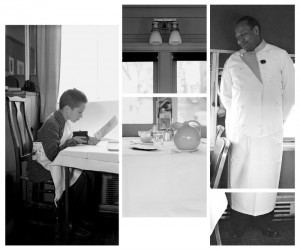
Reference photo for Norman Rockwell’s “Boy in a Dining Car, 1946. Photo montage created by Ron Schick. Licensed by Norman Rockwell Licensing, Niles, IL. From the permanent collection of Norman Rockwell Museum.
McNay Art Museum, San Antonio, Texas June 5, 2013 – September 1, 2013
Photography has been a benevolent tool for artists from Thomas Eakins and Edgar Degas to David Hockney. And to illustrators, always on the lookout for better ways to meet deadlines, the camera has long been a natural ally. But the thousands of photographs Norman Rockwell created as studies for his iconic images are a case apart. A natural storyteller, Rockwell envisioned his narrative scenarios down to the smallest detail. Yet at the easel he was an absolute literalist, who rarely painted directly from his imagination.
From the beginning of his career Rockwell employed professional models, but in time the long hours of static poses impeded his evolving naturalism. Adopting photography in the late 1930’s, he began to call on friends and neighbors to model and bring new flesh-and-blood realism to his work. Their cooperative enthusiasm in front of the camera and unassuming tolerance for his demands enabled Rockwell to capture difficult poses and nuanced expressions more spontaneous than any professional model could deliver. Photography opened a door to the keenly observed authenticity that defines Norman Rockwell’s art. And for us today it is a revelation to discover that so many of his most memorable characters were, in fact, real people.
Curator and author Ron Schick is the first to undertake a frame-by-frame study of the Norman Rockwell Museum’s newly digitized photography archive, the product of a just-completed two-year “Save America’s Treasures” project that has preserved the artist’s archive of almost 20,000 negatives and made accessible the full range of the artist’s photography. The book Norman Rockwell: Behind the Camera was published by Little, Brown and Company in 2009.
|
Complete Facts
|
|||||
| Fee | $75,000 | ||||
| Security: | High, all works must be within sight of a trained security officer/staff member at all times during public hours. | ||||
| Environment: | Light level -18 to 22 foot candles for paintings and 5 to 7 foot candles for works on paper and other light restricted objects. Humidity -50% plus or minus 5% and temperature 68 – 72 degrees, no direct sunlight and no direct contact with light fixtures or heating, air conditioning, ventilation, or electrical outlets. | ||||

